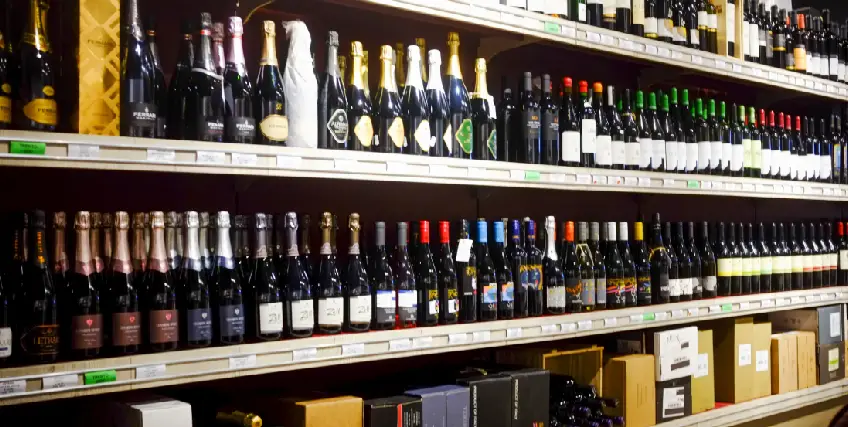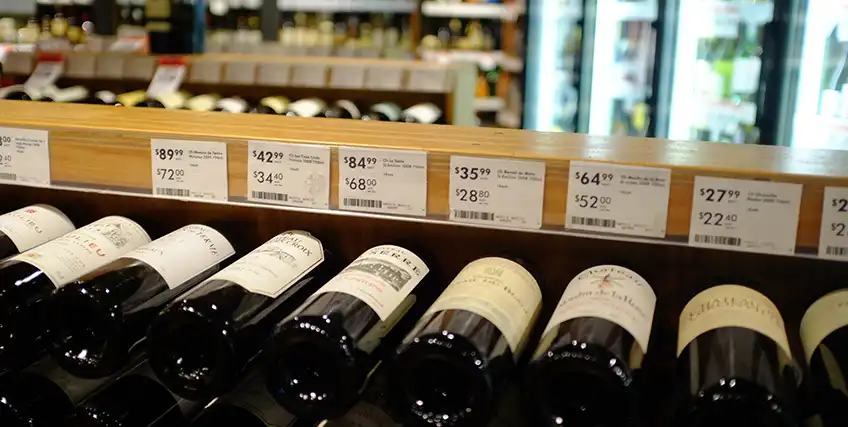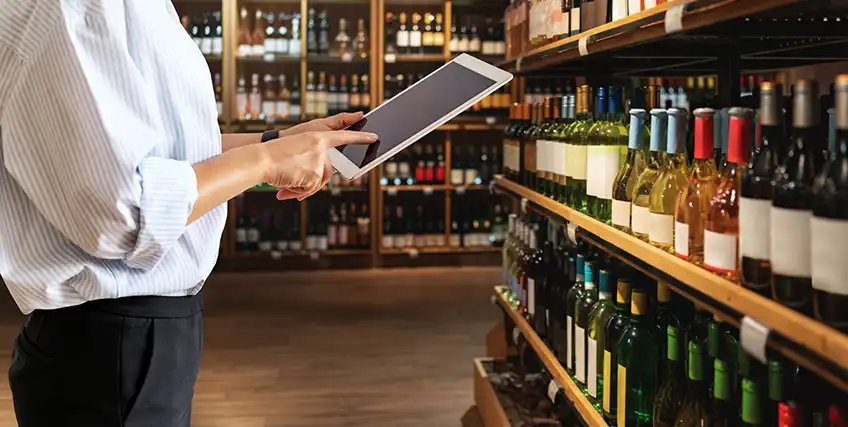How to Manage Liquor Store Inventory
February 18, 2025 | Last Updated on: February 19, 2025

How to Manage Liquor Store Inventory
Liquor store inventory management can be incredibly challenging, particularly for new business owners who are not experienced in managing large inventories. From the number of products liquor stores need to carry to the volume they have to purchase to be able to offer competitive prices, proper inventory management will always mean the difference between success and failure for liquor stores.
While there are several pros to owning a liquor store, the difficulties of managing liquor store inventory is a drawback that you’ll have to navigate.
In this article:
- Key challenges of liquor store inventory management
- Methods small business owners can use to create a liquor store inventory system
- How to utilize a point-of-sale software to smooth business operations and manage liquor store inventory cost
What are the Challenges of Managing Liquor Store Inventory?
Managing liquor store inventory presents several key challenges. We break down some of the most significant here.
Thousands of Products
One of the biggest challenges liquor stores faces is the fact that to remain competitive they have to carry hundreds or even thousands of different products, which are referred to as SKUs. If a liquor store doesn’t, they face losing their customers to what are known as “liquor supermarkets”, which are massive retailers that carry thousands of products.
Even small liquor stores should have a large variety of alcoholic and non-alcoholic beverages, as well as groceries or other conveniences to diversify revenue streams.
Cash Flow Issues
Not only is it difficult to track and stock thousands of products on a regular basis, but it’s also a serious cash commitment. To buy so many different products, liquor stores must lay out large amounts of cash, especially since many states require that liquor stores pay for all their purchases within 30 days of their delivery.
This can cause serious liquidity issues for small businesses, which are often cash-strapped to begin with due to high startup costs and expensive liquor licenses. Compounding this is the fact that to get alcohol for the lowest price possible, retail stores must purchase new products in large volumes. Since liquor stores have to compete with liquor supermarkets, they often have to buy months' worth of supply at a time, further increasing the total cash outlay required.
How to Manage Liquor Store Inventory
It’s not unusual for small business owners to keep track of liquor inventory by hand or in Excel on their computers. For many small businesses, this works just fine. But it’s not sustainable in the long term. The sheer volume of liquor inventory demands a better solution.
Instead, liquor stores should use a point-of-sale system, also known as a POS system. Not only will such a system help with inventory management, but in addition it can help businesses smooth out their entire operation, from promotions and discounts to employee management and more.
What is a POS System?
POS systems, or point of sale systems, are designed to help businesses run their operations through a centralized hub. These systems allow businesses to track and manage inventory in real time, track profit margins, generate sales reports, and more. They can serve as an outstanding liquor store inventory management system while also providing sales data to identify sales trends and inform your future purchase orders to optimize liquor store inventory costs.
A POS system can simplify liquor store inventory and offer many more benefits.
Real-Time Inventory Tracking
One of the best aspects of a liquor store POS system is that it tracks inventory levels in real-time, enabling liquor stores to have sophisticated inventory control. The system updates the inventory levels as soon as an item is purchased. This is much more efficient than updating your inventory at the end of the day, and it will allow you to save vital time and ensure accuracy.
A POS with strong liquor store inventory management can also track both case and individual counts, streamlining reordering and making inventory tracking much easier.
In addition, POS software is designed to allow you to track more than just the sale of an item. You can track broken bottles and other merchandise, customer comps, and more, all of which will be utilized by the software when it generates reports. This will help you see where your business needs to improve.
For example, let’s say there have been a lot of broken bottles and other merchandise in your store recently. You may not notice the problem right away if you’re just marking inventory on paper. You might have even forgotten to keep count of the broken bottles and just reduced the inventory each time something breaks. With a POS system, you’ll not only be able to see how many bottles are being broken, but you’ll also visualize how this is cutting into your profit and impacting your bottom line.
Once you’ve identified that there is an issue, you can then take action to fix the problem, such as retraining staff or adjusting how you arrange items on shelves. This could have a powerful impact on your business.
Instantaneous Understock and Overstock Notifications
POS systems can save you time and money with an understock and overstock notifications feature. Once you get a good idea of the liquor store inventory levels you need to maintain, you can set up the POS system to notify you whenever there is an inventory imbalance and inventory counts are not at the levels they should be.
In a store with thousands of products, it would be incredibly time-consuming to examine the inventory level of each product at the end of each day or week. POS systems do this for you automatically and let you know when there is an issue. This will not only make sure that you have enough inventory to keep your customers satisfied, but it will also ensure that you aren’t overstocking inventory, which will help smooth your cash flow and stock levels.
You could even set up automatic ordering when the system detects understocking on certain products.
Order Scanning
Many POS systems come with handheld scanners that allow you to scan in orders as they’re delivered. Even if the system doesn’t come with scanners, though, it should still be able to track incoming deliveries. This will enable you to catch any of your suppliers' mistakes and keep your overall inventory management system running smoothly and efficiently.
Manage and Track Promotions and Discounts
Liquor store POS software can also track and manage promotions and discounts. Tracking this with your system will ensure your inventory levels, sales revenue, and profit margins are all correct before, during, and after promotions and discounts. Plus, it will let you see how effective a promotion, sale, or discount was. That way, you know whether or not you should repeat it in the future.
Many liquor stores sell gift sets, which include a bundle of multiple products at a value price. When set up properly, POS systems can sell gift sets and keep track of individual liquor inventory simultaneously, preventing inventory count mishaps and inaccuracy.
Customer Rewards and Customer Relationship Management (CRM)
Many liquor stores offer customer loyalty programs. A POS system enables liquor store businesses to offer such programs since it keeps track of customer purchases and resulting points and/or rewards.
These programs are not overly complex and are a great way to manage your customer relationships, keeping shoppers coming back again and again to redeem their rewards and purchase new products. Plus, when customers sign up for the program, the system will record valuable customer information like their email address, name, and phone number. This information is invaluable for customer management and marketing efforts, as it will give you ways to reach out to and market to your loyal customers by sending e-mails and other promotional material to them.
Complete Integration
POS systems are not just limited to one store; they can be used to manage multiple stores and even an e-commerce website. This means that a POS system will allow your business to expand as much or as little as you want. If your goal is to have more than one store eventually, a POS system will enable you to do that. It can also simplify online sales or in-store pickup.
Ultimately, a POS system offers two core benefits to business owners: efficiency and scalability. Both of these are valuable strengths for any business. That said, it’s important to remember that the liquor industry is one of the most regulated industries. Whenever you plan to expand your liquor store business into new, unfamiliar territory, such as e-commerce, it’s always best to seek expert advice from qualified lawyers who have a strong knowledge of the industry both on the state and federal levels.
Employee Management
POS systems also allow for greater employee management ability. These systems can track shifts, hours, wages, pay, and more and then compile this data into overall reports for your business.
Report Generation
One of the huge benefits of POS systems is that they can generate several different reports and provide important data for your business, including profit margins, cost of goods sold (COGS), transactions by employees, inventory turnover ratios, and more. These can help you identify your best products and whether particular sales strategies, such as promotions and discounts, work.
Age Verification
The use of fake IDs by minors is a serious problem for liquor stores. Not only are fake IDs becoming increasingly sophisticated in appearance, but the litigious nature of society is increasing as well, meaning it’s more likely for liquor stores to be on the wrong side of a lawsuit. T help prevent such problems, many POS systems now come with age verification systems, which can be used to verify the legitimacy of a driver’s license.
This can help ensure that you and your employees are never duped by a fake ID and reduce the risk of being held liable for a minor getting their hands on alcohol sold by your store.
Theft Prevention
One of the biggest issues liquor stores face is theft. While customers are often responsible for theft, it is often not uncommon for employees to steal, either. Liquor stores are particularly vulnerable because they carry such a large liquor inventory. Theft can go unnoticed for a substantial time, especially if you’re DIYing liquor store inventory.
A POS system will enable you to notice discrepancies in inventory counts early on, allowing you to get to the bottom of the problem quickly before more damage is done. In line with employee management and theft prevention, POS systems also enable businesses to set some restrictions on employees that would otherwise not be possible. These include:
- Receipt void restrictions
- Item void restrictions
- Price edit restrictions
- Cash draw monitoring
Each of these restrictions can help reduce theft.
Final Thoughts
While some small business owners can manage their inventory independently, it’s much easier with a liquor store point of sale (POS) system.
Despite offering sophisticated solutions, POS systems are often reasonably priced. Plus, they offer additional savings in time and efficiency that can offset upfront installation costs.
A POS system provides business owners with detailed and thorough knowledge of their business and its operations, allowing them to make effective, beneficial, and powerful decisions. If you are a liquor store owner or thinking about getting into the liquor store business, we highly recommend you take a look at the various POS systems available and consider how they could help take your business to the next level.
FAQs on liquor store inventory
What are the challenges of liquor store inventory management?
Some of the key challenges of liquor store inventory management include keeping track of thousands of products, preventing theft, and ensuring you’re properly stocked at all times.
How can you improve liquor store inventory management?
Many small business owners manage inventory on paper or with generic computer programs like Excel. A much better way is to implement a point-of-sale (POS) system.
What are the benefits of a POS system?
A POS system has many benefits, most notably the ability to track all of your liquor store inventory in real-time. It provides updated inventory numbers after sales, theft, broken items, and restocking so you always know what’s on your shelves and in the backroom. It also provides useful data for tracking sales trends, informing marketing initiatives, and instituting customer loyalty programs.
How much does it cost to open a liquor store?
POSNation estimates that the cost to open a liquor store ranges between $50,000 and $250,000.
How much does liquor store inventory cost?
Startup inventory alone may cost between $60,000 to $100,000 depending on the size of your liquor store and the variety offered.




